Chapter 7
Multitasking and Siri
In this chapter, we will describe how to multitask and jump between apps on your iPhone. Multitasking means you can leave one app running in the background while you do something else, such as stream Internet radio, listen to turn-by-turn directions, or take Skype calls.
We’ll also introduce you to Apple’s revolutionary Siri service, an artificially intelligent “assistant” that will listen to your voice commands and then send your messages, book your appointments, and search for the information you need—when you need it.
Fast App Switching
The Fast App Switcher enables you to leave many of your apps running in the background. It also lets you switch from the current app to another without stopping the app you’re currently using.
You might wonder when it might make sense to use the Fast App Switcher. Here are a few scenarios when you might want to consider using multitasking on your iPhone:
- Copy and paste from one app (Mail) to another (Calendar).
- Answer a phone call or reply to an SMS message while playing a game, and then jump back into that game without missing a beat.
- Continue listening to Internet radio (such as Pandora or Slacker) while checking your email or browsing the Web.
- Forego waiting for photos to upload to Facebook or Flikr; your photos can be running in the background while you go and do other things on your iPhone.
- Use Skype to call people—now you can leave it running in the background to receive incoming calls (this was not possible before).
Jumping Between Apps
In order to multitask, you need to bring up the Fast App Switcher bar at the bottom of the screen.
- From any app or even the Home screen, double-click the Home button to bring up the Fast App Switcher bar at the bottom of your screen.

- All open apps will be shown on the Fast App Switcher bar.
- Swipe right or left to find the app you want and tap it.
- If you don’t see the app you want on the Fast App Switcher bar, then press the Home button and start it from the Home screen.
- Double-click the Home button again and tap the app you just left to jump back to it.
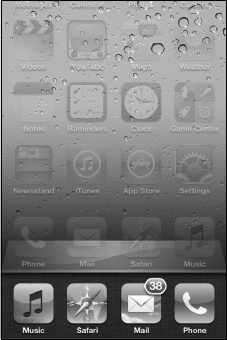
Killing Apps from the Fast App Switcher Bar
Your iPhone will automatically manage its memory, leaving apps open that are doing useful things like streaming music, and putting apps that aren’t doing anything to “sleep,” so they don’t waste memory or processor cycles. Sometimes, however, a rogue process can cause an app not to close properly; at other times, you might want to make certain a GPS or VoIP app closes early to save battery power. In those cases, you can use the Fast App Switcher to manually kill apps.
Built-in apps like Mail and Phone will immediately restart, so you don’t miss any important messages. Apps and games from the App Store will stay closed until the next time you tap their icons to launch them. Follow these steps to kill an app from the Fast App Switcher bar:
- Double-click the Home button to bring up the Fast App Switcher bar.
- Press and hold any icon in the Fast App Switcher bar until they all shake. You will notice that a red Circle icon with a minus sign appears in the upper-left corner of each app icon.
- Tap a red Circle icon
 to completely close the app.
to completely close the app. - Keep tapping the red Circle icons to close as many apps as you want.
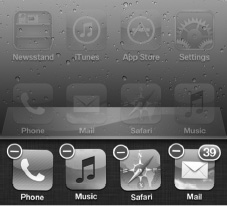
Media Controls and the Screen Portrait Orientation Lock
Swiping from left to right on the Fast App Switcher bar will bring up the media controls and the Portrait Orientation Lock icon. Follow these steps to access these controls and use the Portrait Orientation Lock feature:
- From any app or even the Home screen, double-tap the Home button to bring up the Fast App Switcher bar at the bottom of your screen.
- Swipe left to right to see the media controls and the Portrait Orientation Lock icon.
- Tap the Portrait Orientation Lock icon to lock the screen in Portrait (i.e., vertical) orientation. Your iPhone will maintain this orientation even if you turn it on its side. You know the phone is locked when you see a Lock icon inside the button and another Lock icon in the top status bar.

- The name of the currently playing media is listed at the bottom of the screen.

- You can also use the Previous Track, Play/Pause, and Next Track buttons in the middle. If you hold down Previous Track or Next Track button, it becomes the Rewind or Fast Forward button, respectively.
- Or, you can tap the App icon to jump to the last app that was playing music on your iPhone.
Volume Controls and AirPlay
If you keep swiping as far left as possible on Fast App Switcher bar, you’ll find the volume controls and the AirPlay button. Follow these steps to manipulate these controls:
- From any app or even the Home screen, double-tap the Home button to bring up the Fast App Switcher at the bottom of your screen.
- Swipe left to right, past the media controls, until you get to the volume controls and the AirPlay button.
- Tap the AirPlay button to beam your iPhone audio to AirPlay compatible speakers, your video to Apple TV, or to mirror your apps on the Apple TV.
- Slide the Volume control left to reduce the volume; slide it to the right to increase it.

Siri: Your Virtual Assistant
Siri is an artificially intelligent virtual personal assistant that is context and relationship aware. This means that you can ask Siri questions, and it will not only answer you, but do things for you like tell you wife you’re running late, wake you up from a nap in 15 minutes, recommend you bring a raincoat if you’re going outside, find you a place to get a cup of coffee, or tell you who starred in your favorite movie. Siri is neither magic nor science fiction, but Apple has given it a personality, so it often feels like a little bit of both.
NOTE: At the time of writing, Siri is still in beta release. Apple is only providing support for English (U.S., U.K., and Australian), French, and German. You can turn it on in other places, but your results may vary. Also, things like location services (the ability to search maps and find places) were not yet working outside the US.
Finally, Siri has different voices for different areas. For example, in the US, Siri has a female voice. In the U.K., Siri has a male voice.
Enabling and Configuring Siri
Before you can start using Siri, you need to turn the service on. Follow these steps to do so:
- Launch the Settings app.
- Scroll down and tap General.
- Tap Siri.
- Toggle the Siri switch to ON.
To change the language, tap Language and choose a language from the list.
As of publishing time, only English in Australia, U.K. and U.S.; French; and German are supported.
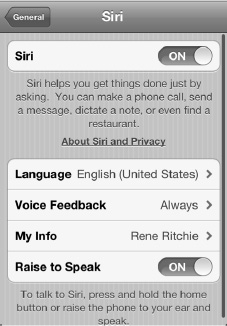
You can choose whether Siri talks back to you Always or only when Hands Free. If you don’t like the idea of your phone speaking out loud, set this option to Hands Free only. If you want to experience Siri in a more interactive way, leave it set to Always.
To let Siri know who you are, so Siri can call you by name, set My Info to your own contact card.
Setting the Raise to Speak option to ON causes Siri to activate and ask what you’d like any time you wake your iPhone from sleep (by pressing the Sleep/Wake button on the top or the Home button on the front) and bring it up to your ear.
Using Siri
To use Siri, press and hold the Home button. (Or, if your iPhone is on and you enabled the Raise to Speak option in the Settings app as described in the previous section, then you can simply bring your phone to your ear.)

Your Home screen will slide up to reveal a silver Microphone icon. Wait for Siri to beep before you begin to speak; and then speak in a clear voice, at a moderate speed, just as you’d speak to another person. When you’re done speaking, wait for Siri to beep again. It is at this point that all the fun begins.
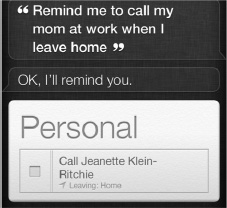
What You Can Ask Siri
Apple recommends that you talk to Siri the same way you’d talk to another person. Don’t try to remember a set list of commands or queries—there are far too many types and variations to remember them all. Instead, just ask Siri for what you want. Here are some examples of what Siri can do for you:
- Set up reminders, calendar appointments, and clock alarms and timers.
- Send texts, messages, and emails.
- Play music.
- Search for location-based information like restaurant and business listings. You can also search for directions to locations.
- Search Yelp (in the U.S.), Wolfram Alpha, and Google for information.
- Ask about the weather and stocks.
- Read your SMS/iMessage messages.
- Take dictation in any app.
- Ask silly questions—Apple has actually programmed in funny responses to many of these.
More impressively, Siri can combine many of these functions to accomplish complex interactions. For example, Siri can read a message requesting a dinner date, search for a restaurant, get directions, send back a confirmation message, and then add an appointment for the dinner—all as part of an interactive confirmation.
Here are just some of the things you can ask, and some of the ways you can ask them:
- “Siri, remind me to call my mom at work when I leave home.”
This will cause Siri to create a reminder, set the departure location as your home address, and pop up an alert with your mom’s work number that’s ready to dial when you leave.
- “Siri, tell my boss I’ll be there soon.”
Siri will get the contact that’s defined as your boss, take the mobile phone number, and send her an SMS/iMessage with the following content: “I’ll be there soon.”
- “Siri, read my messages.”
Siri will read any new SMS or iMessages that have come in.
- “Siri, wake me up in 30 minutes.”
Siri will set a clock timer that will go off in 30 minutes (hopefully, when your nap is over).
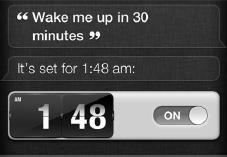
- “ Siri, do I need a raincoat today?”
Siri will check the weather, see if it’s likely to rain, and let you know if you need to worry about getting wet.
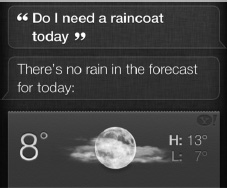
- “Siri, tell me a joke.”
Siri might just start the one about the two iPhones that walked into a bar…

- “Siri, where can I get Italian for lunch?”
Siri will search for nearby restaurants and show them to you on a map. In the U.S. it can also order them by Yelp ranking.
- “Siri, who starred in the movie, Serenity?”
Siri will search Wolfram Alpha and give you a cast list from the movie.
- “Siri, what’s your favorite color?”
Siri will give you one of several replies, perhaps saying that your language lacks the dimensions to properly describe the right shade of green.
The results that Siri returns will sometimes be in the form of widgets that you can adjust or disable if you made a mistake. For example, you can quickly turn off an Alarm widget, check off a Reminder widget as done, tap an email address into a Contact widget, and so on.
Note that Siri isn’t perfect, yet. For example, sometimes it will misunderstand you. At other times, the servers will be overly busy. So, Siri will make mistakes and do the wrong thing on occasion. But over time, it will get better as it learns more about you, and you learn more about how to phrase your questions and instructions.
It’s best just to play with it at first. Experiment with it as much as you can to get a sense of what gives you the best results.
Changing Names and Setting up Relationships
You might have noticed in the preceding examples that we used words like mom and boss, and Siri understood who we were talking about. Before Siri can do that, however, you need to set these people up. Here’s how:
- Hold down the Home button to launch Siri.
- Tell Siri whom you want to set up the relationship for, and what the relationship is. For example, you might say: “Jane Smith is my mother.”
- Siri will ask whether you want it to remember “Jane Smith” as your mother.
- After the beep, say “yes.” (Or, just tap the Yes button.)
- Siri will confirm with this statement: “OK, I’ve added this relationship.” Next, you will see your updated contacts card.

NOTE: Siri can’t remove relationships once they’re created. If you make a mistake or want to change a relationship later, then you’ll have to go to the Contacts app, tap Edit, and manually Delete the relationship yourself.
If you want Siri to call you by a nickname—say, Bob instead of Robert or even something silly like Master—you can easily make the change:
- Hold down the Home button to launch Siri.
- Tell Siri the new name you want to be called by saying something like, “Call me Bob.”
- Siri will ask if you want it to remember Bob as your new name.
- After the beep, say “yes.” (Or, you can just tap the Yes button.)
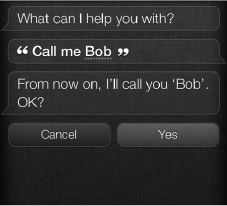
- Siri will confirm the action with a statement like this: “OK, I’ve added this name.” You will then see your updated nickname on a contacts card.
Taking Dictation
The keyboard of the iPhone 4S introduces a new feature: a small Microphone button immediately to the left of the Space bar.
![]()
Tap it and your screen will slide up to reveal a glowing, purple microphone. Speak to it as you would to Siri; when you’re finished, tap the Done button. Everything you say will be transcribed and entered as text.
No text-to-speech engine is perfect, but Siri does a pretty good job transcribing what you said. If it makes any mistakes, you can edit the text just as you would text that you type with the keyboard.
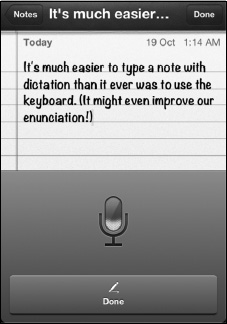
In addition to basic words and names, Siri can understand a wide range of symbols and punctuation. For example, you can say “period,” “exclamation point,” or even “open parenthesis” or “close square bracket.” You can also say, “new line” or “new paragraph.” Indeed, you can use Siri to enter almost any character that you know the proper name of.
What Siri Can’t Do
Siri can do so many things right out of the box that it can be hard to remember what it can’t do. That said, Siri is an online service, and Apple can and will continue to add new functionality over time. Just because Siri can’t do something today doesn’t mean it won’t be able to do that same task tomorrow. At the time of writing, here are some things that Siri can’t do:
- Siri can’t toggle settings. You can’t tell it to turn Wi-Fi on or off, or go into Airplane mode.
- Siri can’t launch apps. You can’t tell it to launch Facebook or your favorite game.
Siri can’t read emails or Twitter replies or anything beyond messages. You’ll have to get a third-party app like Tweet Speaker if you need that functionality.
